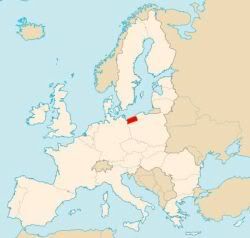Hesland
From Ipon
| |||||||
| Motto: Les gens, les choix Translation: The people, the choices | |||||||

| |||||||
| Hesland @ Simtropolis | |||||||
| Capital | Rollance | ||||||
| Largest city | Rollance | ||||||
| Official language(s) | French | ||||||
| Government Monarch
President | Unitary presidential republic Queen Julie Jacques Girard | ||||||
| Republic Declared Recognized | 1952 1955 | ||||||
| Area • Total • Water (%) | 15,470 km² 5% | ||||||
| Population • 2007 est. • N/A census • Density | 14,770,000 (64) N/A 156/km2/km² () | ||||||
| GDP (PPP) • Total • Per capita | $620 400 Billion $32,182 | ||||||
| HDI | 0.934 | ||||||
| Currency | Euro (EUR)
| ||||||
| Time zone • Summer (DST) | Hesland Time (UTC+1) Hesland Time DST (UTC+2) | ||||||
| Internet TLD | .he | ||||||
| Calling code | +311
| ||||||
The Grand Republic of Hesland, or commonly Hesland, or Heslandie in French, is a small but populated country in Northeast Europe. Hesland borders the Baltic Sea to the north, Poland to the east and south, and Germany to the west.
History
Before the existence of the nation, the location of Hesland was under Polish rule. In the early 1800's, a large separatist group in Northwest Poland wanted to break away from the Polish Empire and start a new kingdom. When Napoleon tried to invade Russia in the 1800's, these separatists took Napoleon's side and broke away from Poland.
The new nation, under Napoleon's rule, was named Hesland, or Heslandie in French. French became the only official language due to Napoleon's influence. After the fall of Napoleon, Hesland became under its own jurisdiction. After Napoleon's defeat, several explorers found new islands in the Caribbean and the South Pacific, and colonized them.
In the late 1940's, the people of Hesland became increasingly upset of being under the rule of a king. In 1950, the people went against the government, and began a bloodless revolution known as the Heslandic revolution. In 1952, the king handed over the government to the people, and a new president took over the newly declared Grand Republic of Hesland. Today, there is no king, only a monarch Queen Julie IV.
Geography
Hesland is a primarily low-lying country, with no mountains whatsoever, and most of the population living at 10 to 30 meters above sea level. Due to its low-lying situation, several floods have created what are now permanent lakes and lagoons. Hesland is home to two major rivers, River LeDuc and River Rollance. The capital city (Rollance), is based on the River Rollance, which gives the city its name. Several small and flat islands can be found off the coast of Hesland's shores. The biggest is Brumes, which can be found home to several agricultural developments.
Because of the nation's flat lands, most of the rural areas are occupied by farms, which produce mainly wheat. Hesland is a temperate maritime climate, and winds blowing southwest give the nation cool summers and mild winters.
Under construction, check back later for more coming soon


